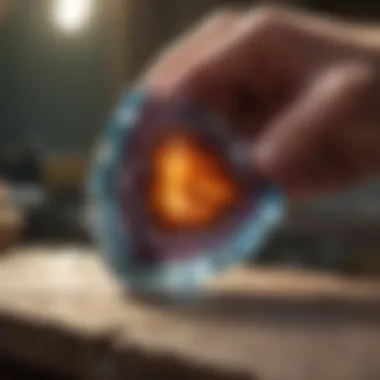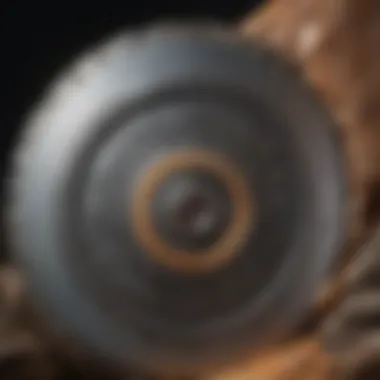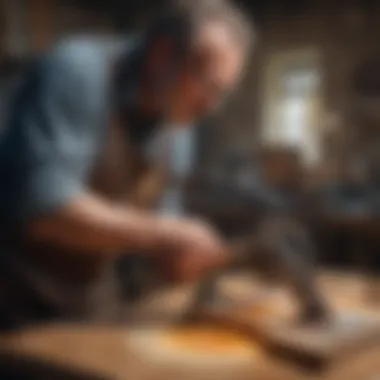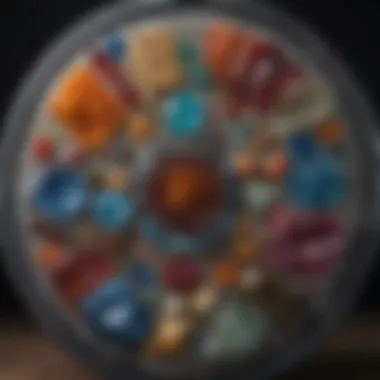Unraveling the Intricacies of Operating a Lapidary Slab Saw for Rock Enthusiasts


Rock and Fossil Identification
In the realm of lapidary practices, rock and fossil identification play a crucial role in the process of selecting the right materials for cutting and shaping. Understanding the various types of rocks and fossils is essential, as different specimens may require distinct cutting techniques. Characteristics such as hardness, texture, and color are key indicators that lapidary enthusiasts should look for when identifying rocks and fossils. Utilizing tools such as magnifying glasses, streak plates, and hardness picks can aid in the accurate identification of materials.
Collecting Tips and Techniques
When it comes to collecting rocks and fossils for lapidary purposes, adhering to best practices is paramount. Enthusiasts should prioritize ethical collection methods that minimize environmental impact and respect legal regulations. Locating prime collecting sites involves research, networking with other collectors, and obtaining necessary permits. Safely extracting specimens from geological formations requires tools such as rock hammers, chisels, and safety goggles to prevent injuries and ensure the preservation of the specimen's integrity.
Preservation and Display
Preserving rocks and fossils after they have been cut and shaped is a delicate process that requires careful attention to detail. Techniques such as sealing with resin, wrapping in acid-free paper, and storing in airtight containers can help maintain the specimens' quality over time. Proper storage methods include keeping specimens away from direct sunlight, moisture, and fluctuations in temperature to prevent deterioration. Displaying rocks and fossils creatively can enhance their aesthetic appeal, with options like shadow boxes, floating shelves, and custom-made stands offering unique presentation possibilities.
Geological Insights
Exploring the geological aspects of rocks and fossils opens doors to understanding the Earth's history and processes. Studying geological formations provides insights into the environments in which rocks were formed, such as sedimentary layers or volcanic deposits. The historical significance of certain rocks and fossils sheds light on past ecosystems, climate conditions, and evolutionary patterns. Notable discoveries in the field of geology have led to breakthroughs in our understanding of Earth's geological timeline and major events that shaped its landscapes.
Introduction to Lapidary Slab Saws
In the realm of lapidary work, the importance of a Lapidary Slab Saw cannot be overstated. It serves as a fundamental tool in the cutting and shaping of various rocks and gemstones, laying the foundation for intricate designs and polished finishes. This section aims to delve deep into the intricacies of utilizing a Lapidary Slab Saw, shedding light on its critical role in the lapidary craft. By exploring specific elements such as cutting capabilities, types of materials, precision cutting, and efficiency in shaping, readers will gain a comprehensive understanding of the significance of a Lapidary Slab Saw in rock enthusiasts' endeavors.
What is a Lapidary Slab Saw?
Definition and Overview
When delving into the world of lapidary arts, understanding the Definition and Overview of a Lapidary Slab Saw is paramount. This specific aspect encapsulates the essence of the tool, highlighting its purpose in rock cutting and shaping. The Definition encompasses the functionality and structure of the saw, providing a clear picture of how it aids in transforming raw rocks into polished gemstones. Its Overview offers insights into the size, power, and capabilities of the saw, painting a comprehensive picture for enthusiasts. The unique feature of a Lapidary Slab Saw lies in its precision cutting ability, allowing for intricate designs and detailed shaping. While advantageous in its accuracy, some may find its size and power consumption to be potential drawbacks, factors to consider when incorporating it into lapidary work.
Key Components
Key Components play a crucial role in the effectiveness of a Lapidary Slab Saw. These essential elements contribute to the saw's overall functionality, ensuring smooth operation and optimal results. The Key Components typically include the blade, motor, table, and water cooling system, each serving a specific purpose in the cutting process. The blade is responsible for making precise cuts, while the motor provides the necessary power to operate the saw efficiently. The table offers stability and support to the workpiece, allowing for accurate cuts. The water cooling system helps manage heat generated during cutting, ensuring the blade remains sharp and the material does not overheat. Understanding and maintaining these Key Components are vital for maximizing the performance of a Lapidary Slab Saw.
Purpose and Functionality
Cutting Capabilities
Exploring the Cutting Capabilities of a Lapidary Slab Saw unveils its versatility in processing a wide range of rocks and gemstones. This specific aspect showcases the saw's ability to make precise cuts, intricate shapes, and smooth finishes. The Cutting Capabilities of the saw make it a popular choice among rock and fossil collectors who seek to create custom pieces with unique designs. Its agility in handling various materials, from soft to hard rocks, makes it a beneficial tool for lapidary enthusiasts looking to expand their cutting techniques.
Types of Materials


The range of Types of Materials that can be effectively handled by a Lapidary Slab Saw further emphasizes its importance in the lapidary field. From common gemstones to exotic minerals, this saw accommodates a diverse selection of materials, each requiring specific cutting techniques. Understanding the properties of different materials and how they respond to the blades of the saw is crucial for achieving desired cutting outcomes. The unique feature of the saw's adaptability to various materials enables lapidary artists to experiment with different stones, pushing the boundaries of creativity and craftsmanship.
Importance in Lapidary Work
Precision Cutting
Precision Cutting stands as a pillar of importance in the realm of lapidary work, and a Lapidary Slab Saw excels in this aspect. The precision offered by the saw ensures accurate cuts, sharp edges, and intricate details, crucial for creating bespoke pieces of jewelry or decorative items. Precision cutting not only enhances the visual appeal of the finished products but also reflects the skill and expertise of the artisan. The unique feature of precision cutting with a Lapidary Slab Saw lies in its ability to achieve micrometer-level accuracy, setting the standard for quality craftsmanship in the lapidary community.
Efficiency in Shaping
Efficiency in Shaping is another vital aspect where a Lapidary Slab Saw shines brightly. The saw's efficiency lies in its capability to streamline the shaping process, allowing for quick material removal and sculpting of rocks and gemstones. This efficiency translates to time savings for lapidary artists, enabling them to focus on creative design aspects rather than laborious shaping tasks. The unique feature of the saw's efficiency in shaping is its ability to deliver consistent results with minimal effort, making it an indispensable tool for those seeking productivity and precision in their lapidary endeavors.
Understanding the Mechanics
In delving deeper into the intricate world of using a lapidary slab saw, it is paramount to grasp the fundamental aspect of understanding the mechanics governing this tool. By comprehending how a lapidary slab saw operates, individuals can harness its full potential in cutting and shaping rocks and gemstones with precision and finesse. Understanding the mechanics provides a foundational knowledge base that is indispensable for both novice and experienced users, offering insights into maximizing efficiency and ensuring safety throughout the lapidary process.
How Does a Lapidary Slab Saw Work?
Blade Operation
Exploring the blade operation of a lapidary slab saw unravels a crucial component essential to its cutting prowess. Blade operation dictates the cutting precision, speed, and overall performance of the tool. The choice of blade operation can significantly impact the quality of cuts and the range of materials that can be worked on. Understanding the nuances of blade operation equips users with the ability to select the most appropriate blade for specific cutting needs, enhancing the utility and effectiveness of the lapidary slab saw.
Water Cooling System
The water cooling system embedded within a lapidary slab saw plays a pivotal role in ensuring operational efficiency and blade longevity. By dissipating heat generated during cutting processes, the water cooling system prevents overheating of the blades, thereby enhancing their durability and maintaining cutting precision. This unique feature of water cooling systems not only improves cutting performance but also contributes to a safer working environment, minimizing the risk of accidents or blade damage. Understanding the significance of the water cooling system is essential for optimizing the functionality of a lapidary slab saw.
Maintenance and Safety
Delving into the maintenance and safety practices associated with using a lapidary slab saw underscores the importance of regular upkeep and protective measures. Blade care tips focus on preserving the sharpness and effectiveness of the blades, ensuring consistent cutting performance. By following recommended blade care practices, users can prolong the lifespan of their blades and maintain cutting precision over time. Protective gear is another crucial aspect that cannot be overlooked when operating a lapidary slab saw. By donning appropriate protective gear such as goggles, gloves, and aprons, users can safeguard themselves against potential hazards, ensuring a safe and secure working environment.
Blade Care Tips
Understanding the intricacies of blade care tips unveils essential practices aimed at enhancing the longevity and efficacy of lapidary saw blades. Proper cleaning, storage, and usage techniques can substantially prolong the lifespan of blades, minimizing wear and tear while maximizing cutting performance. By incorporating recommended blade care tips into regular maintenance routines, users can optimize the cutting capabilities of their lapidary slab saws, facilitating smooth and efficient operation.
Protective Gear
Acknowledging the significance of protective gear in lapidary work highlights its role in ensuring operator safety and well-being. Protective gear such as goggles shields the eyes from potential debris and splashes, while gloves protect hands from sharp edges and abrasions. Utilizing appropriate protective gear not only mitigates safety risks but also instills confidence and peace of mind during cutting and shaping processes. Prioritizing the use of protective gear is essential for creating a secure and conducive working environment when using a lapidary slab saw.


Mastering Techniques with a Lapidary Slab Saw
In the realm of lapidary work, mastering techniques with a lapidary slab saw holds paramount importance. This section of the article is dedicated to unraveling the intricate art of using this tool with finesse and precision. Effective handling of a lapidary slab saw is crucial for achieving meticulous cuts and polished finishes on rocks and gemstones. Readers will delve into the essential elements, benefits, and considerations associated with mastering techniques using a lapidary slab saw. Whether it's achieving optimal cutting angles or enhancing polishing skills, mastering the techniques with this tool opens up a world of possibilities for rock enthusiasts.
Preparing the Workpiece
Securing the Stone
Securing the stone before cutting plays a crucial role in the lapidary process. The way a stone is secured impacts the precision and safety of the cutting procedure significantly. Utilizing clamps or grip pads to secure the stone firmly in place ensures stability during cutting, preventing slippage and potential accidents. Choosing the right method of securing the stone is vital for maintaining control and accuracy throughout the cutting process. While clamping provides a secure hold, grip pads offer flexibility and adaptability for varied stone shapes and sizes. Evaluating the advantages and disadvantages of each securing technique aids in selecting the most suitable approach according to the specific requirements of the workpiece.
Marking for Precision Cuts
Marking a stone for precision cuts is a meticulous task that sets the foundation for the entire cutting process. Accurate markings delineate the desired shape or design on the stone, guiding the cutting path with precision. Employing markers or scribes to outline cutting lines ensures that each cut conforms to the predetermined design, facilitating seamless shaping of the stone. The distinct feature of marking for precision cuts lies in its ability to translate creative visions into tangible stone designs effectively. While precision markings enhance the accuracy of cuts, improper markings can lead to deviations from the intended shape, emphasizing the importance of meticulousness and attention to detail in this preparatory stage.
Executing the Cut
Optimizing Blade Speed
Optimizing the blade speed is a critical factor in achieving efficient and clean cuts with a lapidary slab saw. Adjusting the speed according to the hardness of the material being cut is vital for preventing chipping or fragmentation. A higher blade speed is suited for softer stones, ensuring swift cutting without undue pressure, while a slower speed is preferable for harder or more delicate materials to maintain precision. The unique feature of blade speed optimization lies in its role in determining the quality and smoothness of the cuts, influencing the overall outcome of the shaping process. Balancing blade speed with cutting techniques enhances cutting efficiency and minimizes material wastage, showcasing the significance of this aspect in the lapidary workflow.
Maintaining Control
Maintaining control over the cutting process is essential for achieving consistent and accurate results. Proper grip and positioning of the workpiece enable the operator to guide the stone along the cutting path smoothly, minimizing vibrations and deviations. The key characteristic of maintaining control lies in the operator's ability to anticipate and adjust for any irregularities during cutting, ensuring uniformity in the final product. Effectively controlling the movement of the stone enhances cutting precision and facilitates the creation of intricate designs with sharp edges and defined shapes. While maintaining control requires practice and skill development, its advantages in terms of achieving desired cutting outcomes make it a fundamental aspect of using a lapidary slab saw.
Finishing Touches
Smoothing Edges
Smoothing edges after cutting is a crucial step in refining the appearance and texture of the stone. Utilizing abrasive tools or sanding pads to smooth rough edges enhances the overall aesthetic appeal of the cut stone, preparing it for further polishing stages. The key characteristic of edge smoothing lies in its ability to eliminate jagged edges and irregular surfaces, creating a seamless transition between facets or surfaces. Implementing proper edge smoothing techniques contributes to the visual appeal and tactile quality of the final piece, highlighting the importance of this finishing touch in lapidary work.
Polishing Techniques
Polishing techniques play a pivotal role in enhancing the luster and shine of a cut stone, elevating its visual impact and market value. Employing polishing compounds or discs to buff the surface of the stone brings out its inherent colors and patterns, adding a professional finish to the lapidary creation. The unique feature of polishing techniques lies in their ability to transform a dull stone into a dazzling gem, accentuating its natural beauty and intricacies. While polishing enhances the aesthetic appeal of the stone, mastering the right techniques and finishes is crucial for achieving consistent and high-quality results in lapidary work.
Advanced Tips and Best Practices
When delving into the intricacies of using a lapidary slab saw, it is imperative to grasp advanced tips and best practices to maximize efficiency and precision in rock cutting and shaping. By implementing these strategies, enthusiasts can elevate their craft and achieve superior results. Advanced tips encompass a range of methods and considerations that go beyond basic operations, enhancing the overall proficiency with the tool. Best practices serve as guidelines to streamline processes and ensure optimal outcomes. In this article, we will explore how incorporating advanced tips and best practices can significantly impact the quality of work in lapidary endeavors.


Enhancing Efficiency
Optimal Blade Selection
Optimal blade selection plays a pivotal role in the efficiency and effectiveness of lapidary slab saw operations. Choosing the right blade ensures smooth cutting, minimal wastage, and precise shaping of rocks and gemstones. The key characteristic of optimal blade selection lies in its compatibility with the material being processed. Different blades are designed for specific hardness levels and compositions, allowing for tailored cutting performance. By selecting the appropriate blade based on the nature of the workpiece, lapidary enthusiasts can optimize cutting speed and accuracy. Moreover, the unique feature of optimal blade selection lies in its versatility, offering flexibility to adapt to varying stone types and sizes. While advantages include increased productivity and reduced material loss, disadvantages may arise if the blade is not matched correctly to the rock's properties, potentially leading to inefficient cutting and wastage.
Maximizing Saw Performance
Maximizing saw performance is crucial for achieving consistent and high-quality results in lapidary work. This aspect focuses on optimizing all aspects of saw operation, from blade alignment to speed control. The key characteristic of maximizing saw performance is the maintenance of an efficient and calibrated cutting mechanism, ensuring smooth operation and precise cuts. This contributes to the overall goal of maximizing productivity and achieving desired outcomes with minimal disruptions. The unique feature of maximizing saw performance lies in its holistic approach to enhancing every facet of the cutting process, including blade maintenance, water cooling, and operator technique. Advantages of this approach include improved cutting accuracy, reduced blade wear, and enhanced safety measures. However, challenges can arise if saw components are not regularly inspected and maintained, leading to decreased performance and potential safety hazards.
Troubleshooting Common Issues
Blade Alignment Problems
Blade alignment problems can significantly impede the effectiveness and efficiency of lapidary slab saw operations. Misaligned blades can cause uneven cuts, jagged edges, and increased material wastage. The key characteristic of addressing blade alignment problems is ensuring that the blade is perfectly parallel to the workpiece, allowing for straight and uniform cutting. This meticulous alignment process is essential for maintaining cutting precision and minimizing errors during operation. The unique feature of rectifying blade alignment lies in the attention to detail and precision required to realign the blade accurately. Advantages of addressing blade alignment issues include improved cutting quality, reduced material loss, and enhanced operational safety. However, disadvantages may arise if alignment adjustments are not conducted correctly, leading to further misalignment and potential damage to the workpiece.
Overheating Concerns
Overheating concerns pose a common challenge in lapidary slab saw operations, impacting both cutting efficiency and blade longevity. Excessive heat can weaken blades, warp workpieces, and compromise cutting accuracy. The key characteristic of managing overheating concerns is implementing effective cooling systems and periodic rest intervals for the saw. By regulating blade temperature and allowing adequate cooling periods, lapidary enthusiasts can prevent overheating-related issues and maintain consistent cutting performance. The unique feature of addressing overheating concerns lies in the balance between cutting speed and heat generation, ensuring that the saw operates within optimal temperature ranges. Advantages of managing overheating concerns include extended blade lifespan, improved cutting precision, and enhanced overall efficiency. However, challenges may surface if cooling systems are inadequate or operational practices contribute to excessive heat buildup, necessitating proactive measures to mitigate overheating risks.
Exploration and Experimentation
Exploration and Experimentation play a vital role in the realm of lapidary slab saw operation. It is through these processes that lapidary enthusiasts can push the boundaries of their craft, discovering new techniques and honing their skills. Exploring different materials allows artisans to delve into the unique properties of various rocks and gemstones, unlocking creative possibilities and expanding their artistic horizons. Experimentation, on the other hand, involves trial and error, offering a hands-on approach to understanding how different materials respond to the cutting and shaping techniques employed with a lapidary slab saw.
Trying Different Materials
Gemstones
Gemstones are prized for their beauty, durability, and intrinsic value. When using a lapidary slab saw, working with gemstones opens up a world of elegance and sophistication. The key characteristic of gemstones lies in their refractive properties, which result in shimmering colors and striking visual appeal. Gemstones are a popular choice for lapidary work due to their resilience and ability to take on high polish, showcasing their natural brilliance. However, it is essential to note that some gemstones may be prone to cleaving or fracturing during cutting, requiring precise handling and expertise to avoid any damage to these valuable materials.
Minerals
Minerals offer a fascinating array of color, texture, and composition for lapidary artists to explore. The key characteristic of minerals is their diverse chemical compositions, which give rise to an immense variety of hues and patterns. Working with minerals provides lapidary enthusiasts with unlimited creative opportunities, allowing them to create pieces that reflect the splendor of the Earth's geological diversity. While minerals may not possess the same hardness as gemstones, they offer unique patterns and formations that add a distinctive charm to lapidary creations. It is important to be mindful of the structural integrity of minerals during cutting, as some may be brittle and prone to breakage if not handled with care.
Creative Cutting Techniques
Freeform Shapes
Engaging in freeform cutting techniques opens up a world of artistic expression and imagination for lapidary craftsmen. The key characteristic of freeform shapes is their organic and unconstrained nature, allowing artisans to sculpt stones in non-traditional and visually captivating ways. Choosing freeform shapes for lapidary work offers artists the freedom to follow the natural contours and patterns of the raw material, resulting in truly unique and one-of-a-kind creations. While freeform cutting allows for artistic freedom, it also requires a steady hand and a keen eye for proportion to ensure that the final piece maintains balance and aesthetic appeal.
Intricate Patterns
Intricate patterns introduce a level of detail and precision that elevate lapidary creations to works of art. The key characteristic of intricate patterns lies in the meticulous attention to detail and design complexity involved in their execution. Opting for intricate patterns adds a sense of sophistication and intricacy to lapidary pieces, showcasing the artisan's dedication to craftsmanship and skill. However, working with intricate patterns requires patience and precision, as any errors can detract from the visual impact of the final piece. It is imperative for lapidary craftsmen to approach intricate patterns with a steady hand and a focus on achieving flawless execution for stunning results.







